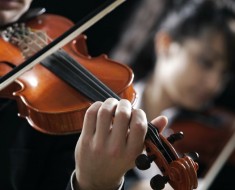In this the year of the Russian composer’s centenary, his music is being played everywhere in celebration of perhaps the finest music talent of the twentieth century. His inventive and spontaneous music (he rarely corrected his original thoughts) can never be separated from the political circumstances through which he lived. The worst of Stalinism, however, was still in the future when, still a student, he wrote his first symphony. I heard it this week performed by the superb Philharmonia Orchestra under its peerless conductor, Christoph von Dohnanyi.
The symphony may be the work of a young man handling with almost feverish haste the results of his studies of Stravinsky, Mahler, Berg and Bartok, but it has the undeniable personality of a composer who already wants to amaze his listeners with frequent key and rhythmical changes, as idea chases idea culminating in as exultant and overwhelming a climax as any in the classical genre. The orchestra played with a precision and, when it needed to, a power that gives credibility to the suggestion that it is Britain’s premier orchestra.
Certainly it must be our most innovative and representative orchestra, with residencies in Bedford, Leicester, Basingstoke and Bristol, as well as in Paris and Bruges.
Pierre-Laurent Aimard was the soloist in the second half, and I had the advantage of hearing him interviewed before the concert. A delightful and cultivated man, he is a keen advocate of contemporary music. Having Pierre Boulez as his mentor when only 19 and winning the 1973 Messiaen Competition were no doubt partly responsible for his wish to balance a classical training with a commitment to new music. He often plays music by the British composer, George Benjamin, neglected in his own country but performed on the continent. This evening he was playing with delicate skill and evident delight, Beethoven’s 4th Piano Concerto.
It was an enchanting performance, with total rapport between orchestra and soloist, in this ‘cat and mouse’ concerto.
It was interesting to see an unconventional lay-out of the orchestra. Second violins were to the right of the conductor, violas and cellos in a fan in front of him and at the rear of the orchestra behind the horns and woodwind, the double bass, lending a dependably solid back-up to the sound. Where we were seated behind the orchestra it seemed to work well. Adrian Boult used to have the second violins where the cellos usually are, as well. There is a constant dialogue between the two sets of strings and it makes sense this way. Today Vernon Handley preserves the same practice. I just felt a bit sorry for the players at the last desk of second violins, their backs squeezed against the bass drum on one side and menaced by the cymbals and the side drum on the other.
B.R.



